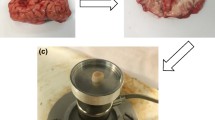Abstract
Magnetic resonance elastography (MRE) is an increasingly used method for non-invasive determination of tissue stiffness. MRE has shown its ability to measure in vivo elasticity or viscoelasticity depending on the chosen rheological model. However, few data exist on quantitative comparison of MRE with reference mechanical measurement techniques. MRE has only been validated on soft homogeneous gels under both Hookean elasticity and linear viscoelasticity assumptions, but comparison studies are lacking concerning viscoelastic properties of complex heterogeneous tissues. In this context, the present study aims at comparing an MRE-based method combined with a wave equation inversion algorithm to rotational rheometry. For this purpose, experiments are performed on in vitro porcine brain tissue. The dynamic behavior of shear storage (G- and loss (G ′) moduli obtained by both rheometry and MRE at different frequency ranges is similar to that of linear viscoelastic properties of brain tissue found in other studies. This continuity between rheometry and MRE results consolidates the quantitative nature of values found by MRE in terms of viscoelastic parameters of soft heterogeneous tissues. Based on these results, the limits of MRE in terms of frequency range are also discussed.
Similar content being viewed by others
References
Lewa CJ (1991). Magnetic resonance imaging in the presence of mechanical waves. Spectrosc Lett 24: 55–67
Muthupillai R, Lomas DJ, Rossman PJ, Greenleaf JF, Manduca A and Ehman RL (1995). Magnetic resonance elastography by direct visualization of propagating acoustic strain waves. Science 269: 1854–1857
Hamhaber U, Sack I, Papazoglou S, Rump J, Klatt D and Braun J (2007). Three-dimensional analysis of shear wave propagation observed by in vivo magnetic resonance elastography of the brain. Acta Biomater 3: 127–137
McKnight AL, Kugel JL, Rossman PJ, Manduca A, Hartmann LC and Ehman RL (2002). MR elastography of breast cancer: preliminary results. Am J Roentgenol 178: 1411–1417
Ringleb SI, Bensamoun SF, Chen Q, Manduca A, An K-N and Ehman RL (2007). Applications of magnetic resonance elastography to healthy and pathologic skeletal muscle. J Magn Reson Imaging 25: 301–309
Rouviere O, Yin M, Dresner MA, Rossman PJ, Burgart LJ, Fidler JL and Ehman RL (2006). MR elastography of the liver: preliminary results. Radiology 240: 440–448
Woodrum DA, Romano AJ, Lerman A, Pandya UH, Brosh D, Rossman PJ, Lerman LO and Ehman RL (2006). Vascular wall elasticity measurement by magnetic resonance imaging. Magn Reson Med 56: 593–600
Sinkus R, Tanter M, Xydeas T, Catheline S, Bercoff J and Fink M (2005). Viscoelastic shear properties of in vivo breast lesions measured by MR elastography. Magn Reson Imaging 23: 159–165
Sack I, Beierbach B, Hamhaber U, Klatt D, Braun J (2007) Non-invasive measurement of brain viscoelasticity using magnetic resonance elastography. NMR Biomed doi: 10.1002/nbm.1189
Hamhaber U, Grieshaber FA, Nagel JH and Klose U (2003). Comparison of quantitative shear wave MR-elastography with mechanical compression tests. Magn Reson Med 49: 71–77
Ringleb SI, Chen Q, Lake DS, Manduca A, Ehman RL and An K-N (2005). Quantitative shear wave magnetic resonance elastography: comparison to a dynamic shear material test. Magn Reson Med 53: 1197–1201
Vappou J, Willinger R, Breton E, Choquet P, Goetz C and Constantinesco A (2006). Dynamic viscoelastic shear properties of soft matter by magnetic resonance elastography using a low-field dedicated system. J Rheol 50: 531–541
Oliphant TE, Manduca A, Ehman RL and Greenleaf JF (2001). Complex-valued stiffness reconstruction for magnetic resonance elastography by algebraic inversion of the differential equation. Magn Reson Med 45: 299–310
Klatt D, Asbach P, Rump J, Papazoglou S, Somasundaram R and Modrow J (2006). In vivo determination of hepatic stiffness using steady-state free precession magnetic resonance elastography. Invest Radiol 41: 841–848
Brands DWA, Bovendeerd PHM, Peters GWM, Paas M, van Bree J, Wismans JSHM (1999) Comparison of the dynamic behaviour of brain tissue and two model materials. Stapp Car Crash Conference Journal, 1999, Paper no. 99sc21, 5764
Bilston LE, Liu Z and Phan-Tien N (2001). Large strain behaviour of brain tissue in shear: Some experimental data and differential constitutive model. Biorheology 38: 333–345
Hrapko M, Van Dommelen JAW, Peters GWM and Wismans JSHM (2006). The mechanical behaviour of brain tissue: large strain response and constitutive modelling. Biorheology 43: 623–636
Nicolle S, Lounis M, Willinger R and Palierne J-F (2005). Shear linear behavior of brain tissue over a large frequency range. Biorheology 42: 209–223
Shuck L and Advani S (1972). Rheological response of human brain tissue in shear. J Basic Eng 94: 905–911
Thibault KL and Margulies SS (1998). Age-dependent material properties of the porcine cerebrum: effect on pediatric inertial head injury criteria. J Biomech 31: 1119–1126
Franceschini G, Bigoni D, Regitnig P and Holzapfel GA (2006). Brain tissue deforms similarly to filled elastomers and follows consolidation theory. J Mech Phys Solids 54: 2592–2620
Miller K and Chinzei K (2002). Mechanical properties of brain tissue in tension. J Biomech 35: 483–490
Author information
Authors and Affiliations
Corresponding author
Rights and permissions
About this article
Cite this article
Vappou, J., Breton, E., Choquet, P. et al. Magnetic resonance elastography compared with rotational rheometry for in vitro brain tissue viscoelasticity measurement. Magn Reson Mater Phy 20, 273–278 (2007). https://doi.org/10.1007/s10334-007-0098-7
Received:
Revised:
Accepted:
Published:
Issue Date:
DOI: https://doi.org/10.1007/s10334-007-0098-7




